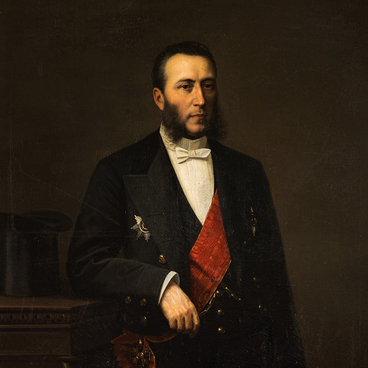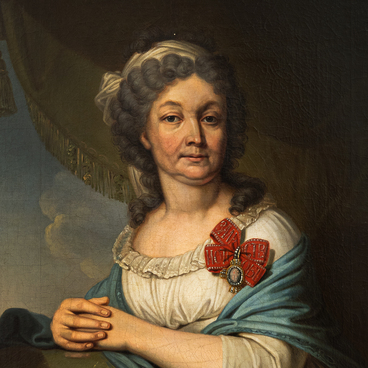In the first half of the 19th century, the merchant class of the provincial town of Volsk was actively forming, developing and establishing its rights. People who became rich in trade often commissioned portraits from little-known artists.
This type of provincial portrait was called merchant-bourgeois. These works often combined the traditions of ‘parsuna’ and secular painting.
Parsuna is a genre of portraits, which appeared in Russian art in the 17th century and was a transition from the icon painting to the secular portrait. The main peculiarity of the parsuna was its flatness and static nature, and the vague resemblance to the depicted person. Gradually the parsuna acquired the features of the secular portrait, which finally took shape by the turn of the 17th — 18th centuries.
In the first half of the 19th century, unknown artists painted many portraits of the Volsk merchant class. Most of them depict people whose names were well known in the city and beyond, however, some of the people in the paintings still have not been identified.
In the merchant hall of the picture gallery of the Volsk Museum of Local History, there are portraits of merchants Zlobin, Sapozhnikov, Kursakovs. These families contributed to the prosperity of the city, developed its economy, and donated money for culture.
This portrait depicts the merchant Avdotya Kursakova from Volsk, the wife of the mayor Yegor (Georgy) Kursakov. An unknown artist painted her as a middle-aged woman in a richly embroidered gray dress and a shawl decorated with pearls and fringe.
Yegor Kursakov was born in 1784 in an Old Believers’ family. As a young man, he left for the southern Urals, in 1818 he joined the merchant class of Kurgan, and in 1822 — the Tyumen merchant class. Having made his fortune, in 1825, Kursakov returned to Volsk with his wife Avdotya and two sons. He enrolled in the Volsk merchant class and became a major supplier of wheat. From 1827 to 1833, Kursakov was elected mayor twice.
The Kursakovs did a lot for their native town: they planted a luxurious garden on the bank of the Volga, and in 1847, they bought a two-story stone house for 10 thousand rubles and donated it to a public hospice. Kursakov’s money was used to fix the house and make it ‘suitable to accommodate the poor and elderly people who do not have money for food.’
The merchant died in 1860 and was buried in the family crypt in Volsk.
This type of provincial portrait was called merchant-bourgeois. These works often combined the traditions of ‘parsuna’ and secular painting.
Parsuna is a genre of portraits, which appeared in Russian art in the 17th century and was a transition from the icon painting to the secular portrait. The main peculiarity of the parsuna was its flatness and static nature, and the vague resemblance to the depicted person. Gradually the parsuna acquired the features of the secular portrait, which finally took shape by the turn of the 17th — 18th centuries.
In the first half of the 19th century, unknown artists painted many portraits of the Volsk merchant class. Most of them depict people whose names were well known in the city and beyond, however, some of the people in the paintings still have not been identified.
In the merchant hall of the picture gallery of the Volsk Museum of Local History, there are portraits of merchants Zlobin, Sapozhnikov, Kursakovs. These families contributed to the prosperity of the city, developed its economy, and donated money for culture.
This portrait depicts the merchant Avdotya Kursakova from Volsk, the wife of the mayor Yegor (Georgy) Kursakov. An unknown artist painted her as a middle-aged woman in a richly embroidered gray dress and a shawl decorated with pearls and fringe.
Yegor Kursakov was born in 1784 in an Old Believers’ family. As a young man, he left for the southern Urals, in 1818 he joined the merchant class of Kurgan, and in 1822 — the Tyumen merchant class. Having made his fortune, in 1825, Kursakov returned to Volsk with his wife Avdotya and two sons. He enrolled in the Volsk merchant class and became a major supplier of wheat. From 1827 to 1833, Kursakov was elected mayor twice.
The Kursakovs did a lot for their native town: they planted a luxurious garden on the bank of the Volga, and in 1847, they bought a two-story stone house for 10 thousand rubles and donated it to a public hospice. Kursakov’s money was used to fix the house and make it ‘suitable to accommodate the poor and elderly people who do not have money for food.’
The merchant died in 1860 and was buried in the family crypt in Volsk.



